The AMD Zen and Ryzen 7 Review: A Deep Dive on 1800X, 1700X and 1700
by Ian Cutress on March 2, 2017 9:00 AM ESTBenchmarking Performance: CPU Rendering Tests
Rendering tests are a long-time favorite of reviewers and benchmarkers, as the code used by rendering packages is usually highly optimized to squeeze every little bit of performance out. Sometimes rendering programs end up being heavily memory dependent as well - when you have that many threads flying about with a ton of data, having low latency memory can be key to everything. Here we take a few of the usual rendering packages under Windows 10, as well as a few new interesting benchmarks.
Corona 1.3
Corona is a standalone package designed to assist software like 3ds Max and Maya with photorealism via ray tracing. It's simple - shoot rays, get pixels. OK, it's more complicated than that, but the benchmark renders a fixed scene six times and offers results in terms of time and rays per second. The official benchmark tables list user submitted results in terms of time, however I feel rays per second is a better metric (in general, scores where higher is better seem to be easier to explain anyway). Corona likes to pile on the threads, so the results end up being very staggered based on thread count.
Blender 2.78
For a render that has been around for what seems like ages, Blender is still a highly popular tool. We managed to wrap up a standard workload into the February 5 nightly build of Blender and measure the time it takes to render the first frame of the scene. Being one of the bigger open source tools out there, it means both AMD and Intel work actively to help improve the codebase, for better or for worse on their own/each other's microarchitecture.
LuxMark
As a synthetic, LuxMark might come across as somewhat arbitrary as a renderer, given that it's mainly used to test GPUs, but it does offer both an OpenCL and a standard C++ mode. In this instance, aside from seeing the comparison in each coding mode for cores and IPC, we also get to see the difference in performance moving from a C++ based code-stack to an OpenCL one with a CPU as the main host.
POV-Ray 3.7
Another regular benchmark in most suites, POV-Ray is another ray-tracer but has been around for many years. It just so happens that during the run up to AMD's Ryzen launch, the code base started to get active again with developers making changes to the code and pushing out updates. Our version and benchmarking started just before that was happening, but given time we will see where the POV-Ray code ends up and adjust in due course.
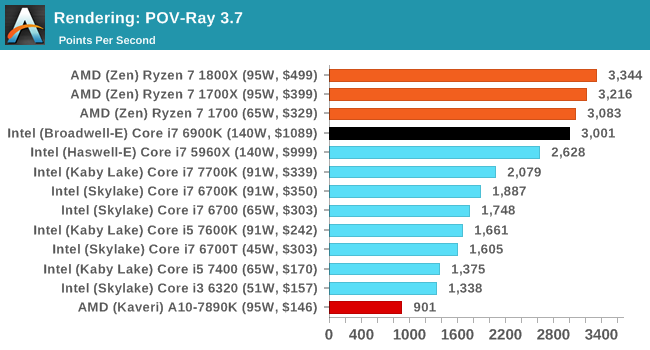
Cinebench R15
The latest version of CineBench has also become one of those 'used everywhere' benchmarks, particularly as an indicator of single thread performance. High IPC and high frequency gives performance in ST, whereas having good scaling and many cores is where the MT test wins out.
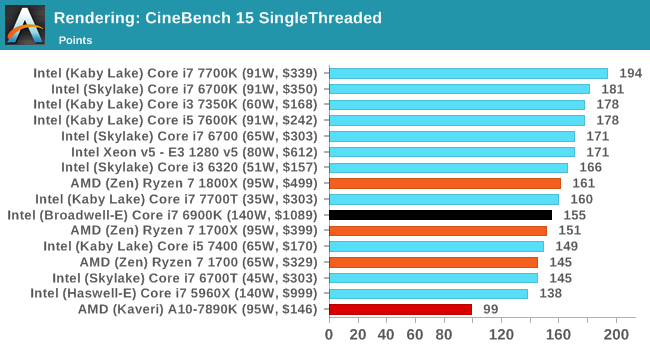
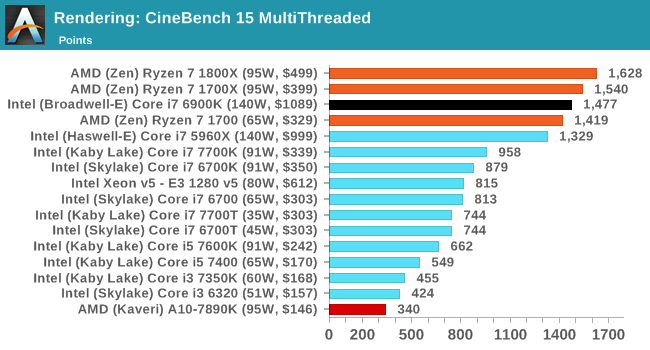


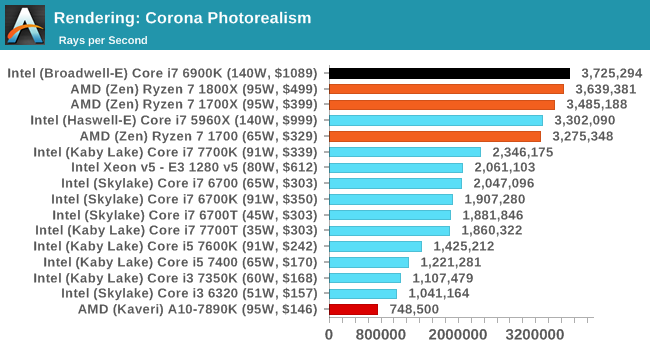
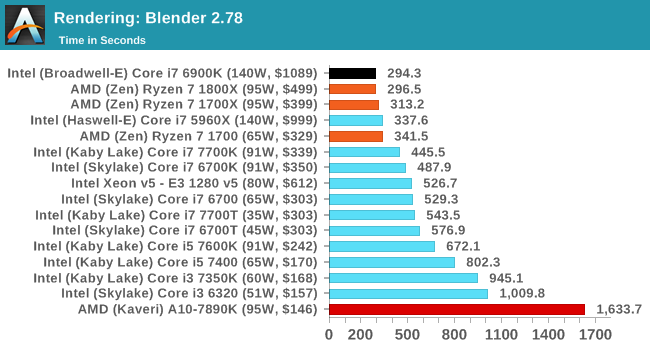

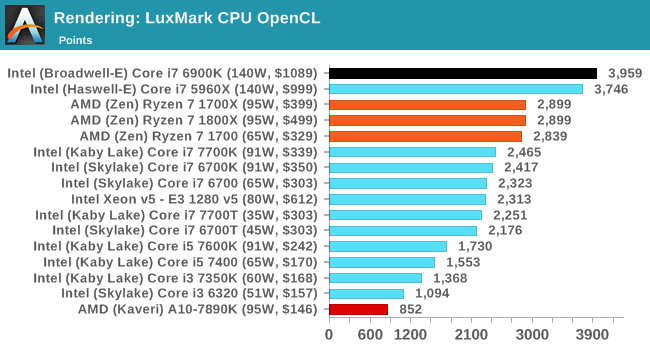








574 Comments
View All Comments
Cooe - Sunday, February 28, 2021 - link
Absolute nonsense. Game code is optimized specifically for the Intel Core pipeline & ESPECIALLY it's ring bus interconnect. There's no such thing as "optimizing for x86". Code is either written with the x86 ISA or its not...FriendlyUser - Thursday, March 2, 2017 - link
The 1700X with a premium motherboard is cheaper and faster than the 6850K. If you absolutely need the extra PCIe lanes or the 8 DIMM slots, then x99 is better, otherwise you are getting less perf/$.mapesdhs - Thursday, March 2, 2017 - link
Or a used X79. I'm still rather surprised how close my 3930K/4.8 results are to the tests results shown here (CB10/ST = 7935, CB10/MT = 42389 , CB11.5/MT = 13.80, CB R15 MT = 1241). People are selling used 3930Ks for as little as 80 UKP now, though finding a decent mbd is a bit more tricky.I have an ASUS R5E/6850K setup to test, alongside a used-parts ASYS P9X79-E WS/4960X which cost scarily less than the new X99 setup, it'll be interesting to see how these behave against the KL/BW-E/Ryzen numbers shown here.
Ian.
Aerodrifting - Thursday, March 2, 2017 - link
"$500 1800x is still too expensive. According to this even a 7700k @ $300 -$350 is still a good choice for gamers."Same thing can be said for every Intel extreme platform processors, $1000 5960X/6900K is still too expensive, $1600 6950X is too expensive, Because 7700K is better for gaming.
Then you said "2011-v3 still offers a platform with more PCIe3 lanes and quad memory channel. ", Which directly contradict what you said earlier about gaming, How does more PCIe3 lanes and quad channel memory improve your FPS when video cards run fine with x8.
Your are too idiotic to even run coherent argument.
lmcd - Thursday, March 2, 2017 - link
What on earth are you talking about? PCIe3 lanes and quad channel memory are helpful for prosumer workloads. It's not contradictory at all?mapesdhs - Thursday, March 2, 2017 - link
Yup, quad GPU for After Effects RT3D, and fast RAM makes quite a difference.Notmyusualid - Friday, March 3, 2017 - link
@mapesdhs:Indeed.
Also, I can actually 'feel' the difference going from dual to quad channel ram performance.
I checked, and I hadn't correctly seated one of my four 16GB modules...
Shutdown, reseat, reboot, and it 'felt' faster again.
Aerodrifting - Thursday, March 2, 2017 - link
Learn to read a complete sentence please."nos024" was complaining gaming performance, Then he pulled out extra PCIe3 lanes and quad channel memory to defend X99 platform even though they were also inferior to 7700K in gaming (just like Ryzen). That makes him sound like a completely moron, Because games don't care about those extra PCIe lane or quad channel memory.
Notmyusualid - Friday, March 3, 2017 - link
X99 'inferior'?I just popped over the 3dmark11's results page, selected GPU as 1080, and I had to scroll down to 199th place (a 7700k clocked to a likely LN2 5.8GHz), to find a system that wasn't triple, or quad channel equipped.
Here: http://www.3dmark.com/search#/?url=/proxycon/ajax/...
So I guess those lanes don't help us multip-gpu people after all?
Swallow.
Aerodrifting - Saturday, March 4, 2017 - link
Because 3Dmark11 hall of fame ranking equals real life gaming performance.Are you a moron or just trolling? Everyone knows when it comes to gaming, A high frequency i7 (such as 7700K) beats everything else, Including 8 core Ryzen or 10 core i7 extreme 6950X.